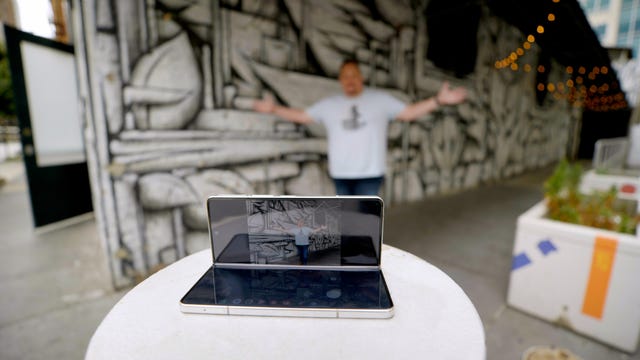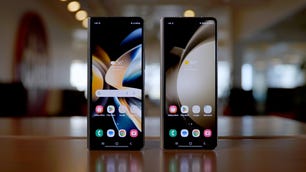I used the Samsung Galaxy Z Fold 5 for a week as a replacement for my phone and my work laptop. Though apps like Slack aren’t exactly optimized for the new $1,800 foldable, the phone proved more than capable of handling the majority of my daily tasks. But it did have its quirks.
For example, Zoom calls over the main screen’s under-display camera were awkward, and not because of the poor image quality. Truth is, most people on the call had no idea I was on the Galaxy Z Fold 5 aside from the strange camera angle, which looked up my nose (unless I put the phone on a pile of cookbooks).
Last year’s Galaxy Z Fold 4 had the same issue when I reviewed it. I share all this because it’s easy to dismiss the Z Fold 5 as a minor upgrade. Yes, it’s definitely an incremental improvement, but it’s a tweak to an already solid and well-established foldable: the Z Fold 4. And when the Z Fold 4 came out last year, it proved how far ahead Samsung was in terms of phones that fold open into a tablet.
The problem is that the Z Fold 5 keeps not only the Z Fold 4 features I enjoyed, but also most of its shortcomings, like that poorly placed low resolution under-display camera. When the Z Fold 5 has its screen bent at a 90 degree angle, the hidden camera sits off to the left side of the screen, which is really only good for checking out my nose hair situation (luckily that’s pretty tidy).
Read more: Samsung Galaxy Unpacked Event: Everything Announced
The other problem is that over the past year, competitors like Google launched their own versions of the Fold, or teased them, like OnePlus has. In my tests, Google’s Pixel Fold had better cameras than the Z Fold 4, though it didn’t beat Samsung’s device overall as “this is as good as it gets right now” for foldables. And that’s where the new Galaxy Z Fold 5 comes in.
It doesn’t bring sweeping design changes but instead tries to improve on the Z Fold 4 in three areas: durability, battery life and cameras. And the Galaxy Z Fold 5 gets two out of those three right… mostly.
Galaxy Z Fold 5 design

The basics of the Z Fold 5 are essentially the same as the Z Fold 4 in terms of the overall design, screen sizes, buttons, USB-C port, software support, S Pen support and, of course, that $1,800 price. The camera bump is less bulky this time around, but the individual lenses stick out more. The main screen is brighter and easier to see outdoors, which is a significant upgrade even if it seems minor.
Like the previous Z Fold, the main screen supports the S Pen Fold Edition but the cover screen doesn’t. This still bums me out. Beyond the lack of an included S Pen in the box, the Z Fold 5 still doesn’t have a built-in pocket or magnetic side to store it. You can buy a new case that includes a notch on the side that the stylus magnetically snaps into, which is slimmer overall than the same case from last year, but it’s pricey and less ideal than an in-device option.
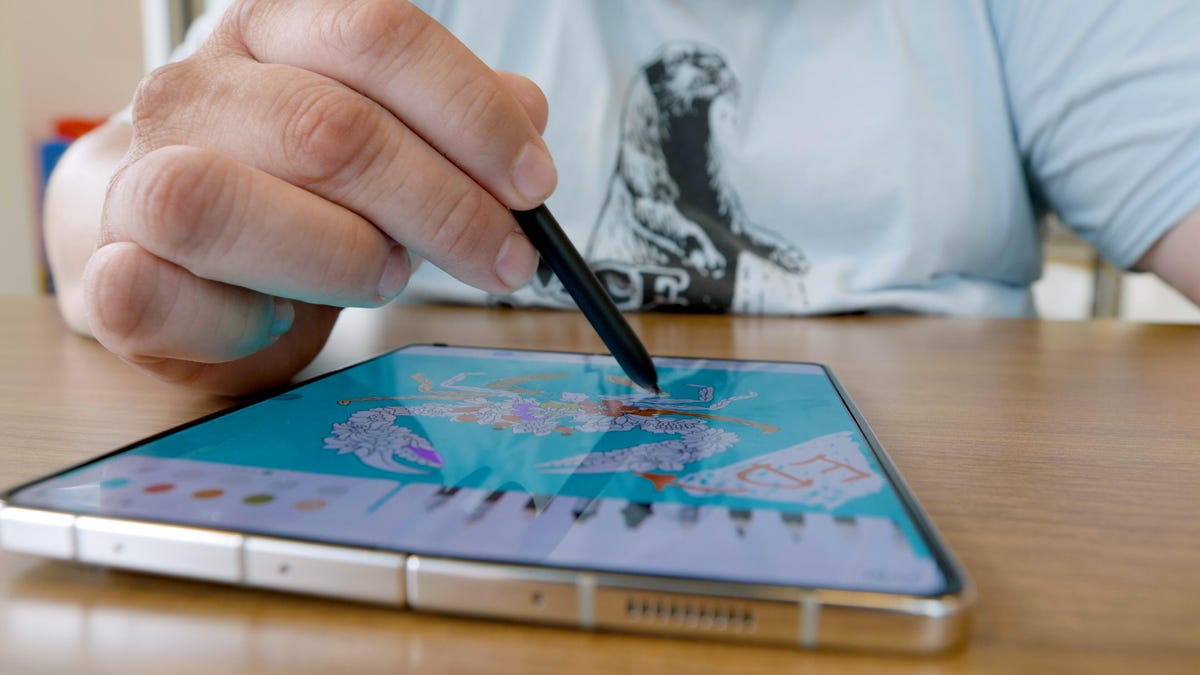
The Z Fold 5’s new hinge changes things. With previous Z Folds, the main screen experience was excellent as a mini tablet, but when closed, it was an awkward phone. It was bulky, and the previous hinge didn’t allow it to close completely flat, leaving an actual wedge-shaped gap between the folded sides.
The Z Fold 5 can close completely shut thanks to that new hinge. Well, the review unit I tested has a thinner-than-paper air gap that you can see through when it’s closed. I imagine it’s much less susceptible to having dust or debris accumulate on the folded screen, but only time will tell. Looking back at how Samsung described the way the Fold 5 closes at the Galaxy Unpacked event, it adds up.
Samsung’s director of product and technology planning, Nils Dahl, said the new hinge “reduces the Fold’s gap to almost nothing.” And that’s almost something.
In my time with the Z Fold 5, it’s much less awkward to hold when it’s folded closed and more enjoyable to use as a “phone.” It still has the same tall thin Sony Xperia 1 V phone aspect ratio that will still be hit or miss for some.
Samsung said the new hinge has fewer mechanical parts and is more durable than previous Z Folds. It’s hard for me to tell if that’s true from just holding it. Though, the Z Fold 5 has an air of being more solid, but that might be because it closes flat now.
The Z Fold 5 is 10 grams lighter than the Z Fold 4, according to Samsung’s specs, and about 12 grams lighter, according to my coffee scale. And that’s definitely something I noticed every time I picked it up.
When I used the Z Fold 5 for work I was amazed by how much I could do. Granted it’s largely the same software experience as the Z Fold 4, but there are some welcome refinements, like the better drag and drop functionality between apps. I also had a much easier time than I did with the Z Fold 4 when it came to pairing Bluetooth headphones and a keyboard and having them reconnect instantly.
Galaxy Z Fold 5 processor and battery
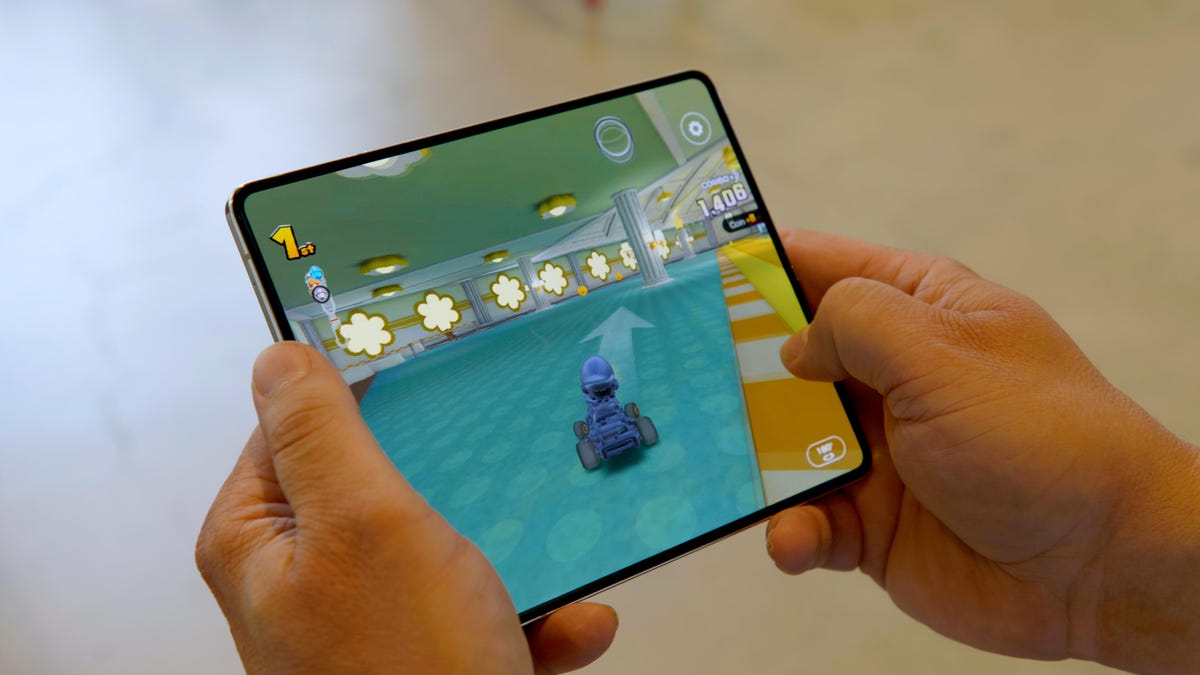
We’ve seen the Snapdragon 8 Gen 2 in a lot of phones this year and it’s excellent in terms of performance and efficiency. The Z Fold 5 and Z Flip 5 have the Snapdragon 8 Gen 2 for Galaxy, a customized version of the chip that debuted in the Galaxy S23 series. Its CPU and GPU get slightly higher speeds than the regular chip, but it’s the efficiency gains that are welcome here.
In use the Z Fold 5 was peppy, and it easily handled having three apps open and active at the same time, even when I made the ultimate time waster and had TikTok, Instagram and X (formerly known as Twitter) open side-by-side on the screen.
In benchmark tests, the Z Fold 5 easily bested the Pixel Fold, the Z Fold 4 and even the Galaxy S23 Ultra in Geekbench 6.
Benchmark testing results
| Phone | Geekbench 6 single-core | Geekbench 6 multi-core | 3D Mark Wild Life Extreme |
|---|---|---|---|
| Samsung Galaxy Z Fold 5 | 2,014 | 5,419 | 3,708; 22.20 fps |
| Samsung Galaxy S23 Ultra | 1,892 | 5,009 | 3,802; 22.8 fps |
| Samsung Galaxy Z Fold 4 | 1,842 | 4,508 | 2,777; 16.60 fps |
| Google Pixel Fold | 1,458 | 3,540 | 1,733; 10.4 fps |
Higher scores are better.
The Z Fold 5 has the same 4,400mAh battery setup as the Z Fold 3 and Z Fold 4. In order to get better battery life with the same battery, and account for that brighter main screen, we need all the efficiency that customized Qualcomm chip can offer. And I’m proud to say that the Z Fold 5’s battery life, so far, has been great.
Over my week with the Z Fold 5, I found it lasts about an hour or two longer on a single charge than the Z Fold 4. The day I used the phone the most was during a video and photo shoot. At 7 a.m. it had a full battery and by 9 p.m. it still had 14% left. And that was with the screen set to 120Hz and being at full brightness most of the day. Over a weekend of medium use, it made it a day and a half on a single charge.
I ran the Z Fold 5 through CNET’s arsenal of battery drain tests. First up was a 45-minute endurance test, during which I made a Zoom video call, raced one course in Mario Kart, played PUBG Mobile for 10 minutes, browsed TikTok, and streamed a video over YouTube. The Z Fold 5 went from 96% to 84%. As you can see below, that’s better than the Z Fold 4, but well behind the Pixel Fold.
45-minute battery endurance test
| Phone | Battery loss over 45 minutes |
|---|---|
| Google Pixel Fold | 5% |
| Samsung Galaxy S23 Ultra | 6% |
| Samsung Galaxy Z Fold 5 | 12% |
| Samsung Galaxy Z Fold 4 | 18% |
Lower percentages are better.
For the next test, I charged the Z Fold 5 up to 100% and streamed a video over Wi-Fi on the phone’s interior screen, checking in hourly to see how much charge it lost. The Z Fold 5 did better than the Z Fold 4, the Pixel Fold and even the Galaxy S23 Ultra. See the results below.
Streaming video test with full battery
| Phone | After 1 hour | After 2 hours | After 3 hours |
|---|---|---|---|
| Samsung Galaxy Z Fold 5 | 96% | 91% | 86% |
| Samsung Galaxy S23 Ultra | 95% | 89% | 82% |
| Google Pixel Fold | 93% | 81% | 69% |
| Samsung Galaxy Z Fold 4 | 89% | 80% | 69% |
Higher percentages are better.
Obviously, how you use the Z Fold 5 and whether you set the main screen at full brightness is going to change how long the battery lasts. For example, I had back-to-back Zoom calls over Wi-Fi on the Z Fold 5 and the battery dropped from 100% to 76% over 75 minutes. This definitely won’t outlast a regular slab phone, but it’s better than its predecessor, even if by just a little bit.
In terms of charging, the Z Fold 5 supports up to 25W (lower than the 45W maximum for the Samsung Galaxy S23 series), but it doesn’t come with a power brick in the box. Over 30 minutes, I charged it with the included USB-C cable and an old 25W charger I had. The battery percent rose from 12% to 68%. The phone also supports wireless charging, and over 30 minutes on a Qi charger the battery recharged from 19% to 38% Both results are better than the Pixel Fold and Z Fold 4.
Galaxy Z Fold 5 cameras

When the Z Fold 5 was announced, I was disappointed to learn that the cameras, lenses and sensors were the same as the previous Z Fold. But at this point, camera hardware upgrades are only half the equation — new processors and CPUs may improve images, too. The Z Fold 5 has a new image sensor processor, or ISP, which in my testing didn’t really change the image quality.
On the whole, photos in bright light look good, but colors are oversaturated. Images taken under medium and low light have soft details and tend to suffer from aggressive noise reduction. The Z Fold 5 isn’t a camera-first phone, but I do wish the cameras took a step forward to meet what Google was able to accomplish with the Pixel Fold’s cameras.
Below are some of my favorite photos and videos that I took with the Z Fold 5.




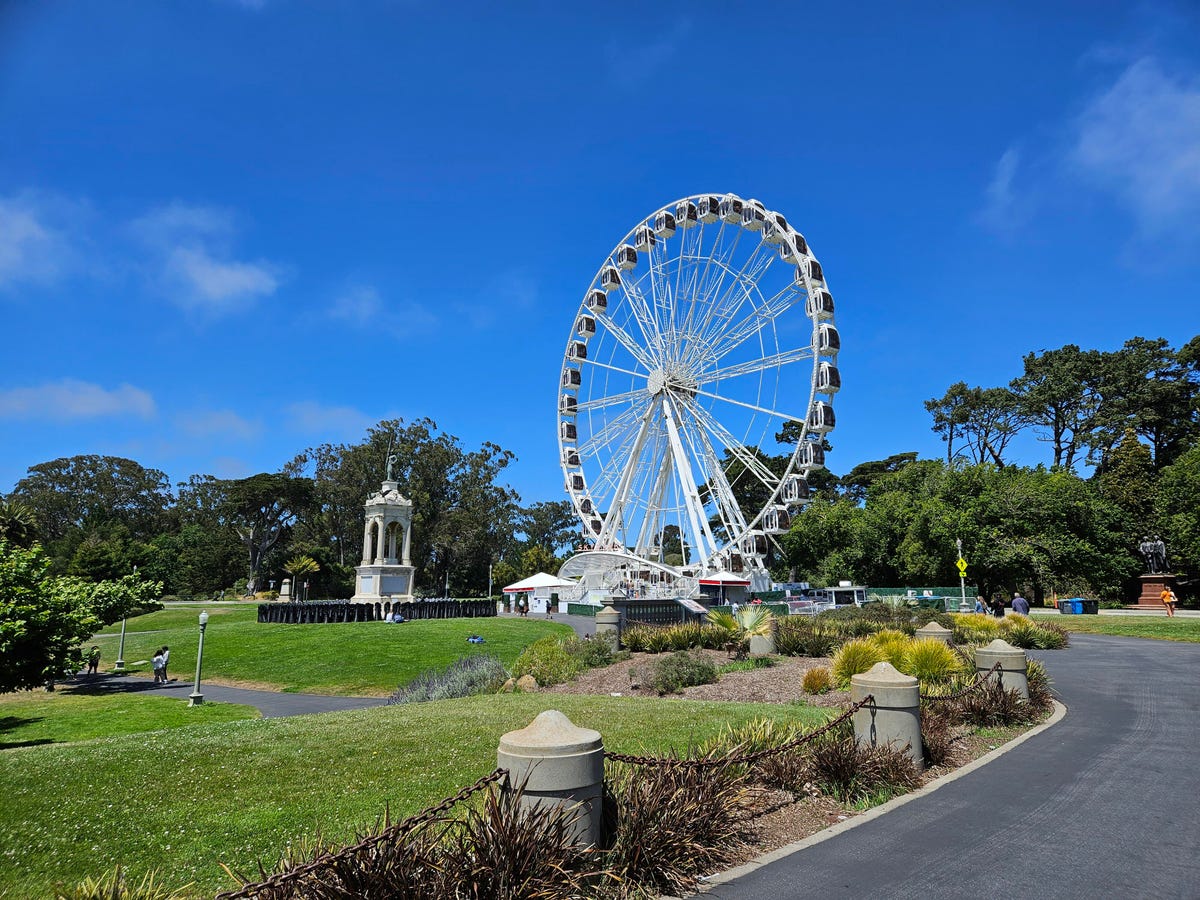


Z Fold 5 photos and videos look identical to those from the Z Fold 4. It’s hard to spot any meaningful differences aside from arbitrary changes in brightness or color temperature. Z Fold 5 photos look a skosh crisper, and that might be because the new ISP allows the cameras to have longer shutter speeds under mixed and medium light, as well as shorter shutter speeds under bright light, compared with the Fold 4. I also noticed that night mode capture times were faster than the Z Fold 4.





A couple of weeks ago, I did a camera comparison between the Z Fold 4 and Google Pixel Fold and found that the Pixel’s cameras were better all around. And though I plan to do another comparison with the Pixel Fold and Fold 5, I don’t see anything to suggest that the Z Fold 5’s cameras have made up any ground on the Pixel.
At the end of the day, the camera performance to dollar ratio is not what you’d expect for $1,800. But this phone isn’t Samsung’s camera gem, that’s the $1,200 Galaxy S23 Ultra. Instead, the Z Fold 5’s price is all about having a phone that can fold open into a tablet.
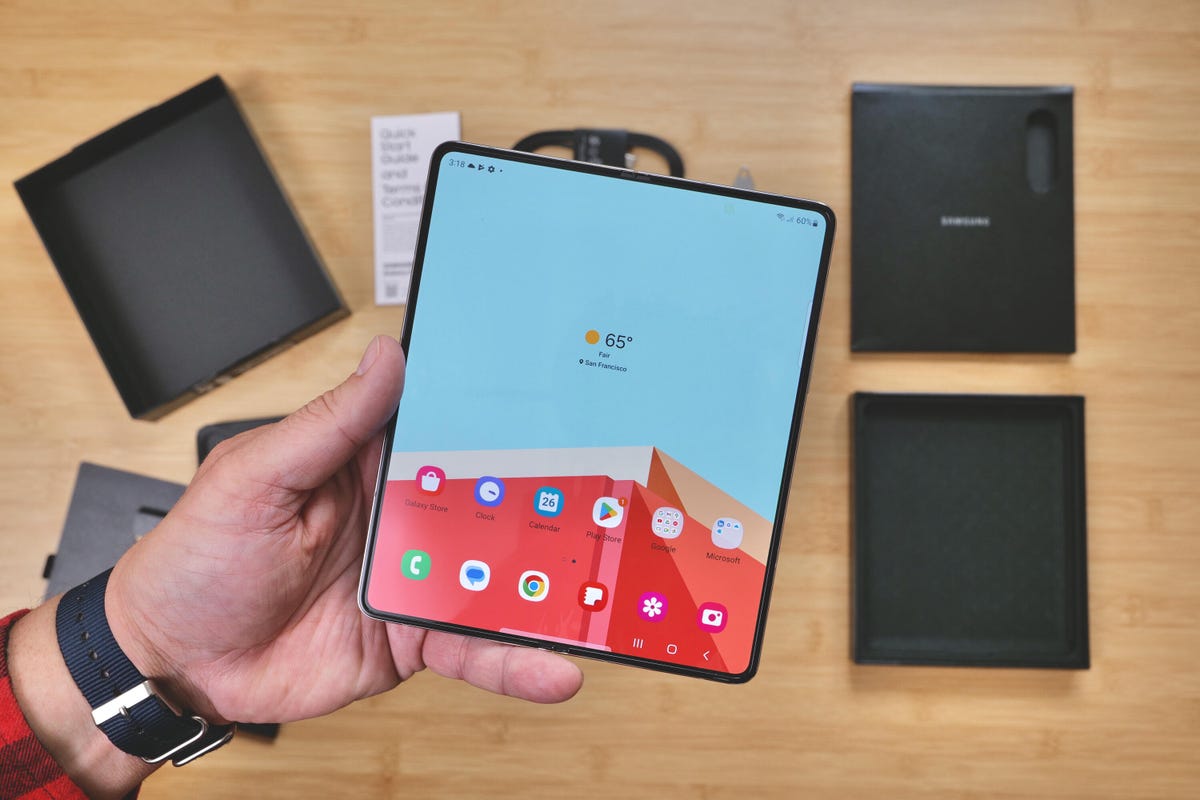
Galaxy Z Fold 5 value and final thoughts
Is the Z Fold 5 worth upgrading from the Z Fold 4? Nope — maybe from the Z Fold 3. But if you’re contemplating upgrading from the original Fold or Z Fold 2, this is a substantial upgrade. You get better cameras, a faster processor, longer battery life, better durability, IPX8 water-resistance, S Pen support and a phone that weighs nearly 30 grams lighter. At this point, the original Fold and Z Fold 2 are also hitting the end of Samsung’s promised software and security updates. I don’t expect people who have an older Fold to upgrade to the Z Fold 5, but Samsung and carriers make it tempting with aggressive discounts for trade-ins.
If you were going to buy a Z Fold 4 a couple of weeks ago, and waited until now and got a Z Fold 5 instead, you’d basically get a better version now for the same price. And like other expensive phones that offer niche appeal, like the $1,400 Sony Xperia 1 V, there are people willing to pay a premium to have a phone that is unique and in this case turns into an amazing mini-tablet. And even if it isn’t for most people, that’s where the Galaxy Z Fold 5 still leads the pack.
Samsung Galaxy Z Fold 5 specs vs. Samsung Galaxy Z Fold 4, Samsung Galaxy Z Fold 3, Google Pixel Fold
| Samsung Galaxy Z Fold 5 | Samsung Galaxy Z Fold 4 5G | Samsung Galaxy Z Fold 3 5G | Google Pixel Fold | |
|---|---|---|---|---|
| Display size, tech, resolution, refresh rate, brightness | Cover: 6.2-inch AMOLED (2,316 x 904 pixels), 1-120Hz; internal: 7.6-inch AMOLED (2,176 x 1,812 pixels), 1-120Hz | Cover: 6.2-inch (2,316 x 904; internal: 7.6-inch AMOLED (2,176 x 1,812 pixels) | Cover: 6.2-inch AMOLED (2,268 x 832 pixels); internal: 7.6-inch AMOLED (2,208 x 1,768 pixels) | Cover: 5.8-inch (2,092 x 1,080 pixels) 60-120 Hz; internal: 7.6-inch OLED (2,208 x 1,840 pixels) |
| Pixel density | Cover: 402 ppi, internal: 374 ppi | Cover: 402 ppi, internal: 374 ppi | Cover: 387 ppi, internal: 374 ppi | Cover: 408 ppi, internal: 380 ppi |
| Dimensions (inches) | Open: 6.1 x 5.11 x 0.24 in; closed: 6.1 x 2.64 x 0.53 in | Open: 6.11 x 5.12 x 0.25 in; closed: 6.11 x 2.64 x 0.62 in | Open: 5.04 x 6.22 x 0.25 mm; closed: 2.64 x 6.22 x 0.63 in; hinge ~0.57in (sagging) | Open: 5.5 x 6.2 x 0.2 in; closed: 5.5 x 3.1 x 0.5 in |
| Dimensions (millimeters) | Open: 154.94 x 129.79 x 6.1 mm; closed: 154.94 x 67.06 x 13.46 mm | Open: 155.1 x 130.1 x 6.3 mm; closed: 155.1 x 67.1 x 15.8 mm | Open:128 x 158 x 6.4 mm; closed: 67 x 158 x 16 mm; hinge: ~14.4mm (sagging) | Closed: 139.7 x 79.5 x 12.1 mm; closed: 139.7 x 158.7 x 5.8 mm |
| Weight (grams, ounces) | 253 g (8.92 oz) | 263 g (9.27 oz) | 271 g (9.56 oz) | 283 g (9.98 oz) |
| Mobile software | Android 13 | Android 12L | Android 11 | Android 13 |
| Camera | 50-megapixel (main), 12-megapixel (ultrawide), 10-megapixel (telephoto) | 50-megapixel (main), 12-megapixel (ultrawide), 10-megapixel (telephoto) | 12-megapixel (ultrawide), 12-megapixel (wide), 12-megapixel (telephoto) | 48-megapixel (main), 10.8-megapixel (ultrawide), 10.8-megapixel (telephoto) |
| Front-facing camera | 4-megapixel (under display); 10-megapixel (cover screen) | 4-megapixel (under display); 10-megapixel (cover screen) | 4-megapixel (under display); 10-megapixel (front cover) | 8-megapixel (inner screen); 9.5-megapixel (cover screen) |
| Video capture | TBD | 4K | 4K | 4K |
| Processor | Snapdragon 8 Gen 2 | Snapdragon 8 Gen Plus 1 | Snapdragon 888 | Tensor G2 |
| RAM/storage | 12GB + 256GB/512GB/1TB | 12GB +256GB/512GB/1TB | 12GB + 256GB/512GB | 12GB + 256GB, 12GB + 512GB (US, UK, Germany) |
| Expandable storage | None | None | None | None |
| Battery | 4,400 mAh (dual-battery) | 4,400mAh | 4,400 mAh | 4,821 mAh |
| Fingerprint sensor | Side | Side | Side | Side |
| Connector | USB-C | USB-C | USB-C | USB-C |
| Headphone jack | None | None | None | None |
| Special features | 5G-enabled, IPX8 water resistance, S Pen support, 25W wired charging, wireless charging, wireless power share, triple SIM | 5G, 30x space zoom camera, IPX8, 25-watt fast-charging (no in-box charger) | 5G-enabled; Foldable display, 120Hz refresh rate (front cover and main display), water resistance, S Pen support | 5G (mmw/Sub6), IPX8 rating, 5x optical zoom, dual SIM, estimated 24-33 hours battery life |
| US price off-contract | $1,800 | $1,800 | $1,800 (256GB); $1,900 (512GB) | $1,799 |
| UK price | 1,749 | 1,549 | 1,599 (256GB); 1,699 (512GB) | 1,749 |
| Australia price | AU$2,559 | AU$2,499 | AU$2,499 (256GB); AU$2,649 (512GB) | Converts to AU$3,340 |
How we test phones
Every phone tested by CNET’s reviews team was actually used in the real world. We test a phone’s features, play games and take photos. We examine the display to see if it’s bright, sharp and vibrant. We analyze the design and build to see how it is to hold and whether it has an IP-rating for water resistance. We push the processor’s performance to the extremes using both standardized benchmark tools like GeekBench and 3DMark, along with our own anecdotal observations navigating the interface, recording high-resolution videos and playing graphically intense games at high refresh rates.
All the cameras are tested in a variety of conditions from bright sunlight to dark indoor scenes. We try out special features like night mode and portrait mode and compare our findings against similarly priced competing phones. We also check out the battery life by using the phone daily as well as running a series of battery drain tests.
We take into account additional features that can be useful, like support for 5G; satellite connectivity; fingerprint and face sensors; stylus support; fast charging speeds; and foldable displays, among others. And we balance all this against the price to give you the verdict on whether that phone, whatever price it is, actually represents good value.

